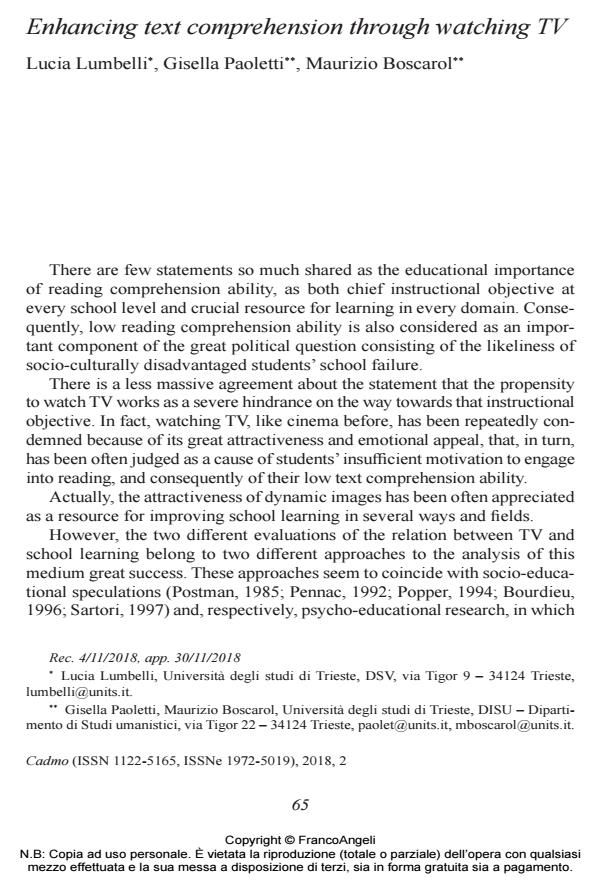Enhancing text comprehension through watching TV
Titolo Rivista CADMO
Autori/Curatori Lucia Lumbelli, Gisella Paoletti, Maurizio Boscarol
Anno di pubblicazione 2019 Fascicolo 2018/2 Lingua Inglese
Numero pagine 13 P. 65-77 Dimensione file 181 KB
DOI 10.3280/CAD2018-002005
Il DOI è il codice a barre della proprietà intellettuale: per saperne di più
clicca qui
Qui sotto puoi vedere in anteprima la prima pagina di questo articolo.
Se questo articolo ti interessa, lo puoi acquistare (e scaricare in formato pdf) seguendo le facili indicazioni per acquistare il download credit. Acquista Download Credits per scaricare questo Articolo in formato PDF

FrancoAngeli è membro della Publishers International Linking Association, Inc (PILA)associazione indipendente e non profit per facilitare (attraverso i servizi tecnologici implementati da CrossRef.org) l’accesso degli studiosi ai contenuti digitali nelle pubblicazioni professionali e scientifiche
The purpose of this experimental research was to analyze the possibility of stimulating student text comprehension through a guided exploration of an amusing TV cartoon that is also difficult to be fully comprehended, using the attractiveness of dynamic images as a resource for improving text compre hension. 38 students of an Italian Secondary School participated to the study. They were 15 years old on average. A group of 19 student received a training for processing the cartoon comprehension difficulties, and was helped in detecting and making the required bridging inferences. A multimedia comprehension post test verified a significant difference between the two groups. The educational implications of the research concern the possibility of using interesting and motivating material for the enhancing text comprehension . The educational treatment performed gave the students the opportunity to acquire a special learning strategy that consists of consciously making the processes that good comprehenders of both written text and audiovisual narratives automatically and correctly are used to make.
Keywords:Text comprehension; TV comprehension; bridging inferences; multimedia; educational strategy.
- Bourdieu, P. (1996), Sur la télévision. Paris: Liber-Raisons d’agir; trad. it. Sulla televisione, Milano: Feltrinelli, 1997.
- Cavazzini, G. (1999), “Abilità di comprensione della lettura: stimolazione individualizzata o collettiva?”, Scuola e città, 12, pp. 508-524.
- Clark, H.H. (1977), “Bridging”, in P.N. Johnson-Laird, P.C.Watson (eds), Thinking: Readings in Cognitive Science (pp. 243-263). Cambridge (UK): Cambridge University Press.
- Cornoldi, C., Colpo, MT Group (1981), Prove oggettive di lettura MT. Firenze: Organizzazioni Speciali.
- Duncker, K.(1935), Zur Psychologie des productiven Denken. Berlin: Springer.
- Ericsson, E.A., Simon H.A. (1984), Protocol Analysis. Cambridge (MA): MIT Press.
- Kintsch, W. (1998). Comprehension: A Paradigm for Cognition. Cambridge (UK): Cambridge University Press.
- Kombartzky, U., Ploetzner, R., Schlag, S., Metz, B. (2010), “Developing and Evaluating a Strategy for learning from Animations”, Learning and Instruction, 20, pp. 424-433.
- Lowe, R.K. (1999), “Extracting Information from an Animation during Complex Visual Learning”, European Journal of Psychology of Education, 14, pp. 225-244.
- Lowe, R.K. (2003), “Animation and Learning: Selective Processing of Information in Dynamic Graphics”, Learning and Instruction, 13, pp. 157-176.
- Lowe, R.K. (2004), “Interrogation of Dynamic Visualization during Learning”, Learning and Instruction, 14, pp. 257-274.
- Lumbelli, L. (1996), “Focusing on Text Comprehension as a Problem-solving Task: A Fostering Project for Culturally Deprived Children”, in C. Cornoldi, J. Oakhill (eds), Reading Comprehension Difficulties. Processes and Intervention (pp. 301-330). Mahwah (NJ): Erlbaum.
- Lumbelli, L. (1999), “Televisione e lettura. Un confronto sperimentale”, IKON, 39, pp. 13-60.
- Lumbelli, L. (2007), “Complex Connective Inference and a Possible Type of Implicature”, Lingue e linguaggio, VI, 1, pp. 85-100.
- Lumbelli, L. (2008), “From Film and Television to Multimedia Cognitive Effects”, in J.-F. Rouet, R. Lowe, W. Schnotz, Understanding Multimedia Documents (pp. 223-247). New York: Springer.
- Lumbelli, L. (2009), La comprensione come problema. Il punto di vista cognitivo. Roma-Bari: Laterza.
- Lumbelli, L., Paoletti, G. (1999), “Imparare a leggere all’università?”, Orientamenti pedagogici, XLVI, 274, pp. 657-675.
- Pennac, D. (1992), Comme un romance. Paris: Gallimard; trad. it. Come un romanzo. Milano: Feltrinelli, 1993.
- Pezdek, K. (1987), “Television Comprehension as an Example of Applied Research in Cognitive Psychology”, in D. Berger et al., Applications of Cognitive Psychology: Problem Solving, Education and Computing (pp. 3-15). Hillsdale: Erlbaum.
- Popper, K.R. (1994), Cattiva maestra televisione. Milano: Donzelli.
- Postman, N. (1985), Amusing Ourselves to Death. New York: Viking.
- Rogers, C.R.(1945), “The Non-directive Method as a Technique in Social Research”, American Journal of Sociology, 50, pp. 279-283.
- Rogers, C.R. (1951), Client-centered Therapy. Boston: Houghton-Mifflin.
- Salomon, G. (1984), “Television is ‘Easy’ and Print is ‘Tough’: The Differential Investment of Mental Effort as a Function of Perception and Attributions”, Journal of Educational Psychology, 76, pp. 647-658.
- Salomon, G. (1979-1994), Interaction of Media, Cognition and Learning. San Francisco: Jossey-Bass.
- Sartori, G. (1997), “Homo videns”. Televisione e post-pensiero. Roma-Bari: Laterza.
- Schnotz,W. (1993), “Comprehension of Graphics in Texts. Introduction”, Learning and Instruction, 3, pp. 151-156.
- Schnotz, W., Bannert, M. (2003), “Construction and Interference in Learning from Multiple Representation”, Learning and Instruction, 13, pp. 141-156.
- Schnotz, W., Lowe, R. (2008), “A Unified View of Learning from Animated and Static Graphics”, in R. Lowe, W. Schnotz, Learning with Animation. Research Implications for Design (pp. 304-356). New York: Cambridge University Press.
- Wood, D., Bruner, J.S., Ross, G. (1976), “The Role of Tutoring in Problem-solving”, Journal of Child Psychology and Psychiatry, 17, 2, pp. 345-378.
Lucia Lumbelli, Gisella Paoletti, Maurizio Boscarol, Enhancing text comprehension through watching TV in "CADMO" 2/2018, pp 65-77, DOI: 10.3280/CAD2018-002005